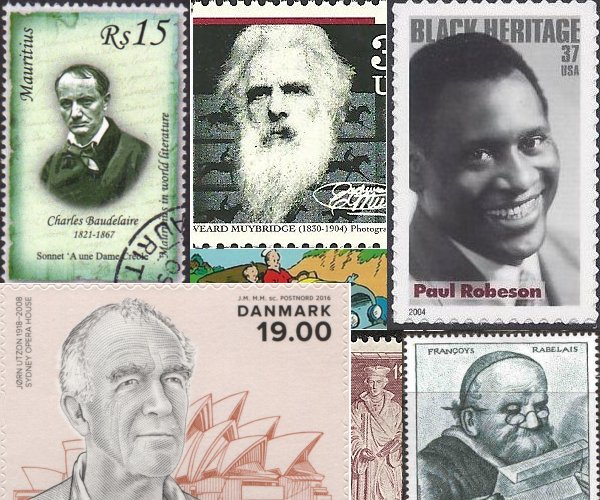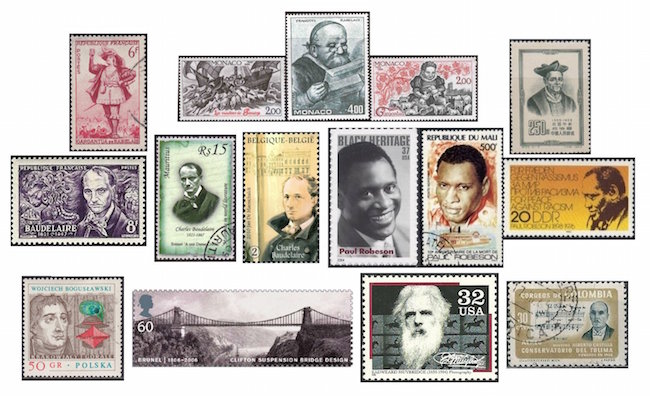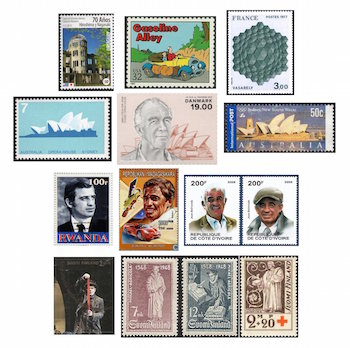The Arts on the Stamps of the World — April 9
An Arts Fuse regular feature: the arts on stamps of the world.

By Doug Briscoe
It’s a star-studded Sunday, as we salute Rabelais, Baudelaire, Paul Robeson, pioneering English photographer Eadweard Muybridge, op art progenitor Victor Vasarely, Finnish composer Aulis Sallinen, and more.
April 9 is the date in 1553 on which François Rabelais died. He may have been born in 1483, but the likelier date is November 1494. A man of voracious intellectual appetite, he was frustrated by the simplicity of the Franciscans and actually petitioned the Pope to join the Benedictines instead. Having already made a name for himself in his studies of law, philology, and science, his request was granted. He went on to study medicine, to work for a printer, and to begin writing his own pamphlets critical of authority and stressing individual liberty. Obviously this sort of thinking led to no good, and the first substantial result of his creative imagination was the scandalous Pantagruel, followed by its prequel Gargantua. French King Francis I thought this was just fine, but upon his demise the doctors of the Sorbonne were not so amused. Rabelais probably went into hiding for a while under the protection of his friend Cardinal du Bellay, then lived in Metz, out of danger. He did return to Paris in his last years, even serving as a curate in two parishes. His later admirers have included Laurence Sterne, Balzac, Anatole France, Hilaire Belloc, and Milan Kundera, who gives him high praise as “the founder [with Cervantes] of an entire art, the art of the novel.”
Still in France but forward in time two centuries and a half, we come to the great poet Charles Baudelaire (April 9, 1821 – August 31, 1867). He, too, came under fire for the daring subject matter and style of his writing; but his first volume of poetry, Les Fleurs du mal (The Flowers of Evil, 1857) was vociferously praised by de Banville, Flaubert, and Hugo. Baudelaire was fined but not imprisoned, and the fine was reduced. Many of these now beloved poems were set by Debussy and Fauré, besides a Who’s Who of other French composers: Chausson, Duparc, d’Indy, Gustave Charpentier, Louis Vierne, Henri Dutilleux, and many more. But the settings are by no means limited to French composers: the Russians Taneyev and Gretchaninov, the Austrians Zemlinsky and Berg, the German Hindemith, Dutchmen Alphons Diepenbrock, Leo Smit, and Hendrik Andriessen, the Italian Alfredo Casella, the Hungarian Ferenc Farkas, Britons Sorabji and Jonathan Harvey, and numerous Americans—Charles Martin Loeffler, Easley Blackwood, Miriam Gideon, Noël Lee, Bernard Rands, Ned Rorem—have all been moved to music by Baudelaire’s words. He is also famous for his art reviews and other articles and for translating the stories of Edgar Allan Poe and Thomas De Quincey’s Confessions of an English Opium Eater. Incidentally, Baudelaire was a dear friend of the pioneer photographer Nadar, whose stamps we just saw three days ago.
What an extraordinary individual was the great Paul Robeson! He excelled not only as a singer and actor, but as a versatile athlete and a dauntlessly courageous advocate for civil rights all over the world. I cannot do full justice to his rich history in this short piece, but I understand that the fine director Steve McQueen has been working on a biopic of Robeson’s life. (Also, the excellent actor and narrator Keith David gave a one-man show in 2014.) In brief, Robeson (April 9, 1898 – January 23, 1976) was born in Princeton, New Jersey and was already performing Shakespeare in high school. He sang in the chorus and distinguished himself not only in football, but also basketball, baseball, and track, all of this while enduring persistent racial prejudice, which dogged him through his years at Rutgers (he was only the third African-American student ever enrolled there) and beyond. And yet his fellow students ended up electing him class valedictorian. He studied law, practiced it for a while, and went on to become an important figure in the Harlem Renaissance. His performance in The Emperor Jones was perhaps the highlight of his early career (he went on to reprise the role in the film), and it was around this time that he experienced the socio-political and ideological awakening that led to the humanitarian path he pursued so tirelessly for the rest of his life. His support for the Republican cause in the Spanish Civil War made him sympathetic to communism, for which in later years he was blacklisted despite his many good works. He became active in the Council on African Affairs, presented an anti-lynching petition in the UN, and took up the cause of Australian Aborigines. Not without flaws, Robeson was repeatedly unfaithful to his wife (he had an affair with the great Peggy Ashcroft while they were doing Othello in London) and stood by the Soviets even when he became aware of their many evils, but even putting aside for a moment his multifarious talents, he consistently exhibited unparalleled courage and steadfastness, a true hero.

The remarkably industrious Wojciech Bogusławski (VOYT-s’yekh bah-gu-SWAHF-ski; 9 April 1757 – 23 July 1829) was a Polish theater director during the Enlightenment. Despite being of the minor nobility he joined a theater troupe in 1778, acted on the stage, and presented his adaptation of another composer’s cantata in opera form. In 1782 he was appointed director of the National Theatre, Warsaw, and undertook tours to other Polish cities. He founded two new theaters, the second of which gave the Polish premiere of Beaumarchais’ Marriage of Figaro. Bogusławski saw the theater as a platform for putting forward nationalist ideas, and he staged and started writing his own “relevant” plays, besides putting on the works of Shakespeare, Racine, Molière, Voltaire, Schiller and Lessing, along with operas. Seen as the “Father of Polish theater”, he also established the first drama school in Poland.
The man with the extraordinary name of Isambard Kingdom Brunel (9 April 1806 – 15 September 1859) accomplished extraordinary things. A brilliant and highly innovative engineer, Brunel, the son of a French engineer and an English mother, designed bridges, tunnels, railways, ships, dockyards, etc. His Thames Tunnel was the first of its kind, beneath a navigable river (unless the Babylonians beat him to it by four millenia, as some have asserted), he added a host of ingenious improvements to Britain’s Great Western Railway, developed the world’s first propeller-driven, ocean-going, iron ship, and designed Paddington Station. His most celebrated work, though, may be the Clifton Suspension Bridge in Bristol, a technological marvel that opened in 1864 and which has been captured on a “wide-screen” 2006 stamp from the UK.
Another remarkable Englishman was the photographer Eadweard Muybridge (9 April 1830 – 8 May 1904). I daresay you’ve seen his work even if the name doesn’t ring a bell. He’s the one who took multiple photographs of moving animals and people and arranged them into a precursor of motion pictures, by the end of his career producing 100,000 such images. He was born Edward James Muggeridge and in his youth lived for a decade in the United States, where he worked as a bookseller. In 1860 he was involved in a stage coach accident in which one other passenger was killed and he suffered a severe head injury, which may have affected his personality for the rest of his life. (Many years later he was exonerated in a murder case in which witnesses testified to the change in his character. This was a seminal legal case, and Philip Glass wrote an opera, The Photographer, about it in 1982). There is much more to Muybridge’s eventful story. On the US stamp from 1996 the frames from his famous study Sallie Gardner at a Gallop (or The Horse in Motion, 1887) appropriately serve as a background for his portrait.
The Colombian composer, poet, and mathematician Nació Alberto Castilla, born on this date in Bogotá in 1878, also experienced some excitement. He joined the liberals in Colombia’s vicious civil war, the Thousand Days’ War (1899-1902), then worked for a while on the Pacific railway. He took up the directorship of the Tolima school orchestra in 1906 and with friends created in a rented house the rudiments of what would become the Conservatory of Tolima. A humanist journalist, Castilla was excommunicated by the church. He died of an aneurysm on June 10, 1937. I found a brief list of his works, which appears to be made up mostly of songs, one of which, “El Bunde”, serves as the anthem of the Tolima Department of Colombia and is represented on the 1964 stamp. I guess there is also a Requiem Mass.

The best known work of Czech architect Jan Letzel (April 9, 1880 – December 26, 1925) was the Japanese Chamber of Commerce and Industry in Hiroshima, a building that survived the atomic blast of 1945 and has been maintained as the A-Bomb Dome or Peace Memorial. Letzel had formed an architectural company in Japan in 1907 and oversaw the construction of about forty buildings. He went back to his homeland in 1913, revisited Japan as commercial attaché in 1919-20, and in a heartbreakingly ironic harbinger of things to come, returned again to Japan in time to see many of his buildings destroyed in the Great Kanto earthquake of 1923. He died two years later at 45.
American cartoonist Frank King (1883 – June 24, 1969) was the creator of “Gasoline Alley”, the longest running American comic strip after “The Katzenjammer Kids”. It began in 1918 (as a daily in 1919) and is still going strong. An interesting aspect of the strip is that it lasted long enough to become the first one to show its characters aging—the character of Skeezix, introduced as a baby, is now is his nineties.
Hungarian-born artist Victor Vasarely (born Győző Vásárhelyi, 9 April 1906 – 15 March 1997) is credited as being one of the first and foremost practitioners of op art, although the movement wasn’t dubbed that until decades later. Vásárhelyi (VAH-shahr-hay-lee) settled in Paris in 1930 and became Vasarely (vah-sah-re-LEE). His work Zebras (1937-38) is seen as perhaps the earliest known example of the kind of optical illusion typified in op art. Another example, Tridimensional Design, is seen on the French stamp of 1977. Vasarely founded two museums to house his work, the first, which closed in 1996, sadly just a year before his death, was in Vaucluse, the other, the Fondation Vasarely in Aix-en-Provence, is said to be poorly maintained.
Danish architect Jørn Oberg Utzon, whose centenary is next year (he lived from 1918 to November 29, 2008), is the creator of the iconic Sydney Opera House. It was named a World Heritage Site in 2007, while Utzon was still living, making him one of only two people to have been thus recognized. Inspired variously by Frank Lloyd Wright, the clay structures of Morocco, and the ancient pyramids of Mexico, he broadened his architectural awareness with visits to China, Japan, and India, all the while maintaining a Scandinavian reverence for nature. The Sydney Opera House design was chosen over 223 other entries and firmly endorsed by Eero Saarinen. I’ve chosen two Australian stamps showing the famous building, one from 1973, the year the house was completed, and a more recent one from 2000. These bookend a very new Danish stamp from just last year honoring the man himself.
One of the most recognized French actors in the world is Jean-Paul Belmondo (born 9 April 1933). Bon anniversaire! The son of a sculptor of Italian descent, Belmondo took to acting after giving up his first love of boxing for fear of having his face rearranged. From the early 1950s he moved from the stage to film, getting his first starring role in Les copains du dimanche (1958), but it was Luc Godard’s Breathless (1960) that put him on the map. His comments suggest a man of rather simple tastes malgré his association with the New Wave and intellectual auteurs. He has made films with Claude Chabrol, Jeanne Moreau, Sophia Loren, Jean Gabin, Gina Lollobrigida, Alain Delon, and many more.
Generally acknowledged to be the finest Finnish composer after Sibelius, Aulis Sallinen (born April 9, 1935) has written six operas to date, along with much striking orchestral music (8 symphonies and half a dozen concertos so far) and chamber scores. There are many fine recordings. The stamp comes from a sheet issued in 2011 to celebrate the Finnish National Opera and shows a scene from Sallinen’s opera The Red Line.
Finally today we pay our respects to Finnish clergyman Mikael Agricola, the “father of literary Finnish”, who died on this date in 1557. Born about 1510, his family name was originally Olaui or Olofsson. No doubt he assumed the name Agricola as an indication of his father’s profession (peasant farmer, but apparently quite a wealthy one). He studied in Wittenberg under Melanchthon and Luther. Agricola’s translation of the New Testament was central to establishing Finnish orthography and literary style. April 9 is recognized as the Day of the Finnish Language, though I wonder how many Finns actively celebrate it.
And a happy 89th birthday to the inimitable and youthful Tom Lehrer (born April 9, 1928), whom I had the great pleasure of meeting just last year.
A graduate of the University of Massachusetts with a B.A. in English, Doug Briscoe worked in Boston classical music radio, at WCRB, WGBH, and WBUR, for about 25 years, beginning in 1977. He has the curious distinction of having succeeded Robert J. Lurtsema twice, first as host of WGBH’s weekday morning classical music program in 1993, then as host of the weekend program when Robert J.’s health failed in 2000. Doug also wrote liner notes for several of the late Gunther Schuller’s GM Recordings releases as well as program notes for the Boston Classical Orchestra. For the past few years he’s been posting a Facebook “blog” of classical music on stamps of the world, which has now been expanded to encompass all the arts for The Arts Fuse.
